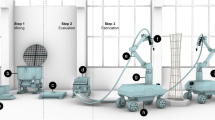Abstract
Thin sections cut from cast concrete cylinders have been examined in transmitted light to investigate the significance of coarse aggregate type in “primary” microfracturing. Concretes manufactured with crushed-rock aggregates and gravel aggregates were studied and, in every case, the dominant fracture type was a parting of the aggregate-matrix bond Bond cracking was least severe with the marble aggregate where epitaxial calcita over-growth was indicated. The ability of bond cracks to maintain continuity by bridging surface irregularities, via mortar cracks, reduced the inhibiting influence of rough-surfaced aggregate on bond-crack development.
Résumé
Des lames minces réalisées sur des cylindres de béton coulé ont été examinées en lumière transmise pour étudier l'importance des granulats grossiers dans la microfissuration “primaire”. Nous avons observé des bétons fabriqués avec des granulats issus de roches massives concassées et des granulats alluvionnaires et, dans tous les cas, le type de fissuration prédominant se présentait sous la forme d'un éclatement de la liaison granulat—matrice. Les fissures étaient moins développées dans le cas de granulats de marbre, à cause de la présence de liaisons épitaxiques. La faculté des fissures de se prolonger en franchissant les inégalités de surface, par l'intermédiaire des fentes dans le mortier, a réduit l'influence modératrice des granulats à surface rugueuse sur le développement des fissures.
Similar content being viewed by others
References
DHIR R.K., HUBBARD F.H., ISLES M.K. & SANGHA C.M. (1982) Fracture mapping and microfracturing in concrete. Res Mechanica 5, 3, 183–201.
DHIR R.K. & SANGHA C.M. (1974): Development and propogation of microcracks in plain concrete. Materials and Structures, 7, 17–23.
DHIR R.K., SANGHA C.M. & MUNDAY J.G.L. (1973): Strength and deformation properties of autogenously healed mortars. Journal of the American Concrete Institute, 70, 3, 231–236.
HSU T.T.C., SLATE F.O., STURMAN G.M. & WINGER G. (1963): Microcracking of plain concrete and the shape of the stress-strain curve. Journal of the American Concrete Institute, Proc. 60, 209–24.
MUNDAY J.G.L., SANGHA C.M. & DHIR R.K. (1974): Comparative study of autogenous healing of different concretes. Proc. 1st Annual Conference on Engineering Materials, University of New South Wales, 177–189.
SANGHA C.M. & DHIR R.K. (1973): Mechanical and structural criteria for the strength of concrete. Properties of Building Materials, Institute of Physics Conference, Cambrige, 1983.
SANGHA C.M., ISLES M.K., HUBBARD F.H. & DHIR R.K. (1981): Fracture micromechanics of plain concrete. Second Australian Conference on Engineering Materials, 73–83.
SHAH C.M. & CHANDRA S. (1981): Critical stress, volume change, and microcracking in concrete. Journal of the American Concrete Institute, Proc. Vol. 65, 770–781.
Author information
Authors and Affiliations
Rights and permissions
About this article
Cite this article
Hubbard, F.H., Dhir, R.K. Aggregate and concrete microfracture. Bulletin of the International Association of Engineering Geology 22, 245–248 (1980). https://doi.org/10.1007/BF02600679
Published:
Issue Date:
DOI: https://doi.org/10.1007/BF02600679




